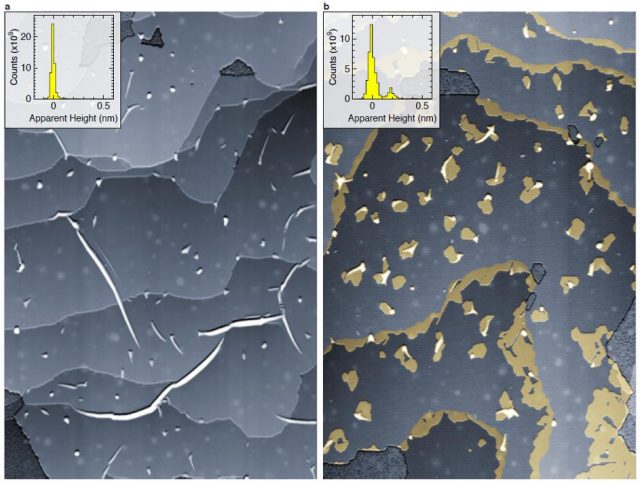How to induce a giant spin-orbit effect in graphene

There are some concepts in physics difficult to grasp. Mainly because we have no direct evidence of them and, in orther to get some understanding, we rely on analogies that are not strictly correct. One of these difficult concepts is the spin of the electron.
The analogy for the spin usually goes this way: Imagine that the electron is like the Earth, orbiting the nucleus which would be like the Sun, and at the same time rotating on its axis. Each motion has its associated angular momentum, which we call the orbital and spin angular momentum, respectively.
This makes it perfectly clear for the student of physics what spin is about, but there is a huge problem. The classical description of electron spin —as resulting from a spinning electron— is incorrect. More recent theory indicates that the electron is a point particle, without spatial extent. Therefore, the electron is not modeled as a rigid object and cannot be considered to be spinning. If we were to model the Earth as a single point, it would have no moment of inertia about its spin axis and thus no spin angular momentum. But only when our analogy includes the finite size of the Earth, spin angular momentum becomes possible.
Despite this conceptual difficulty, all experimental evidence supports the idea that an electron does have some intrinsic angular momentum that can be described by the spin magnetic quantum number. P.A.M. Dirac showed that this fourth quantum number originates in the relativistic properties of the electron.
We have already mentioned that the spin quantum number is a magnetic one. Using our analogy again: The sphere carries an electric charge, so the spinning motion leads to current loops and to a magnetic moment. But, once again, the origin of this spin angular momentum is fundamentally quantum mechanical, so it is not correct to model the electron as a spinning charged sphere. Paradoxical, is it not?
From the point of view of the Earth we can consider that the Sun revolves around it. In our analogy, the nucleus would orbit the electron. But the nucleus has a positive charge, and we know that a moving charge originates a magnetic field. As the electron has an intrinsic magnetic moment (spin) there must be a magnetic interaction between the spin and the magnetic field due to the orbit. This is what is known as spin-orbit effect.
In graphene the spin-orbit effect is negligible, because we are considering carbon atoms, where relativistic effects are very small. This is because the speed of electrons are relatively small as well. Relativistic effects, and stronger spin-orbit interactions, are usually found in heavier elements. However, a measurable spin-orbit effect in graphene would be most desirable as it would have very interesting applications.
Now, a group of researchers, including Mikhail Otrokov, Evgueni Chulkov y Andrés Arnau from DIPC, has recently shown1 that the partial intercalation of one-atom-thick layer of a heavy atom like lead between graphene and an iridium substrate induces the confinement of electrons on this lead islands. The heavy element changes the strength of the spin-orbit interaction, creating a pseudo-magnetic field that alters the energy levels where electrons can be located. The result was published in Nature Physics.
If you decompose ethylene on iridium at very low preassures and high temperatures (some 1,400 K) you get a monolayer of graphene with just a few wrinkles. Then you can use these wrinkles to intercalate some atoms of lead between the graphene and iridium layers just evaporating lead onto the graphene/iridium sample.
Hybrid structures made up of different two dimensional layers may have properties remarkably different from those of each of their components. In this case the lead islands modify de spin-orbit effect in graphene as if it where under a very strong magnetic field. In spite of the local character of the spin-orbit effect, it can be detected at long distances from the physical edge of the lead islands. This reveals the huge distances to which perturbations extend in graphene.
This exotic effect, combined with other features of graphene like the long-range magnetic order induced by the adsorption of molecules, could find good use in spintronics, one of the main goals of current research on graphene oriented to build the electronic devices of the future.
Author: César Tomé López is a science writer and the editor of Mapping Ignorance.
References
- Calleja F., Manuela Garnica, Sara Barja, Juan Jesús Navarro, Andrés Black, Mikhail M. Otrokov, Evgueni V. Chulkov, Andrés Arnau, Amadeo L. Vázquez de Parga & Francisco Guinea & (2014). Spatial variation of a giant spin–orbit effect induces electron confinement in graphene on Pb islands, Nature Physics, 11 (1) 43-47. DOI: http://dx.doi.org/10.1038/nphys3173 ↩
2 comments
[…] How to induce a giant spin-orbit effect in graphene […]
[…] magnetic field destroys the effect. The spin Hall effect is due to spin-orbit coupling (see [1] How to induce a giant spin-orbit effect in graphene for a detailed explanation) and this coupling can be intrinsic or extrinsic to the […]